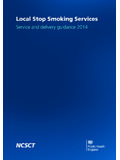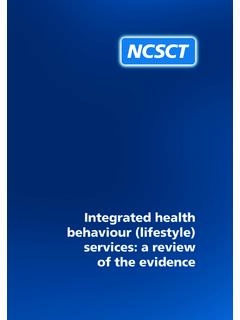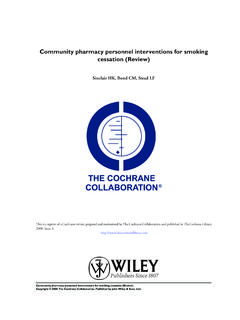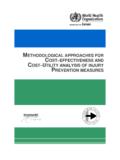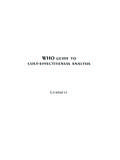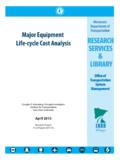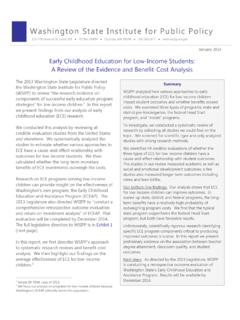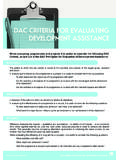Transcription of Cost-effectiveness of pharmacotherapy for smoking cessation
1 Executive SummaryCost- effectiveness analysis , even with its inherent methodological problems, consistently shows thatwhen smoking cessation interventions are effective they are invariably also cost -effective. This is largelydue to their relative low cost and the big impact that stopping smoking has on health is also the case for pharmacotherapy for smoking cessation , including nicotine replacement therapy(NRT), bupropion (Zyban) and varenicline (Champix).There is evidence that varenicline may be more cost -effective than other pharmacotherapy . Evidenceis less conclusive about the relative Cost-effectiveness of NRT compared with bupropion. Combinationtherapy (several forms of NRT, or NRT and bupropion) is also cost -effective compared with brief adviceor counselling alone. While it is likely that combination pharmacotherapy , as compared with mono- pharmacotherapy , is cost -effective it has not yet been directly from economic analyses from the UK and elsewhere confirm that smoking cessation interventions,including pharmacotherapy , are among the most cost -effective health care interventions of pharmacotherapyfor smoking cessation 2012 National Centre for smoking cessation and Training (NCSCT)Author: Lion ShahabEditor: Andy : 7 Key Definitions and methodology Cost-effectiveness compares the impact of two or more alternative courses of action withregards to their costs and benefits.
2 Within the health care setting such cost -effectivenessanalysis (CEA) usually focuses on the additional cost per additional unit of health gaincreated by one compared with another intervention: the incremental cost -effectivenessratio (ICER).1 In contrast to cost benefit analyses, where health-related consequences are expressed inmonetary terms, CEA uses either life-years (LY) or quality adjusted life years (QALY) former simply counts the additional years added to a person s life due to an intervention,while the latter weights these years according to the perceived life quality in terms of a numberof factors such as pain / discomfort, mobility and mental Each QALY is assigneda value between (perfect health) and (death). However, in smoking cessation researchCEA values greater than have been applied as stopping smoking not only reducesmortality but also chronic morbidity; thus a chronic morbidity component has been CEA additionally takes into consideration the fact that the worth of extended life in thefuture is considered to be less than if immediately realised, due to the uncertainties weassociate with future Each LY or QALY is therefore discounted by a fixed amountper year, typically between NICE Guidance The National Institute for Health and Clinical Excellence (NICE) is charged with evaluatingthe effectiveness as well as Cost-effectiveness of treatments in order to make recommendationsabout the implementation in the UK National Health Service (NHS).
3 7 NICE has adopted a Cost-effectiveness threshold of 20,000 30,000 per QALY abovewhich interventions are unlikely to be recommended. However, there is much debate aboutthe correct level of this threshold which is considered implicit rather than explicit8 andvaries enormously between In fact, in NHS settings the cost -effectivenessthreshold for circulatory diseases and cancers is below 20,00010, whilst NICE recommendations in practice have a much higher of pharmacotherapy for smoking : Caveats CEA is ubiquitously used by decision makers. However, there are considerable differences inoutcomes of CEA due to the various assumptions necessary to predict future health There are four main problems of CEA that need to be borne in mind wheninterpreting ,131) QALY: can health be adequately expressed in economic terms at all?
4 Methods requirethat subjective ratings from many people are aggregated into a single ) Costs / uncertainty: how should intersectoral, wider societal costs be evaluated?It is likely that an intervention may have unintended positive or negative costsnot ) Discounting: what is the right threshold? Higher rates will favour acute interventionsover preventative interventions and thus put more value on treatments for the ) Equity: how can the needs of different patient populations ( those from lowersocio-economic groups, those with greater clinical need) be accurately captured?Differential weighting of costs by QALY for different populations may be of single pharmacotherapyThere are three principal forms of pharmacotherapy available on prescription for smoking cessation in the Nicotine Replacement Therapy (NRT) NRT delivers nicotine either through the skin, nasal or buccal mucosa to reduce cravingsand withdrawal symptoms, and the rewarding effects of smoking as well as providing somebehavioural It is available in seven forms (gum, patch, inhaler, lozenge, sublingualtablet, nasal or mouth spray).
5 NRT has been found to be very effective, roughly doublinga smoker s chances of remaining The cost per quitter for brief advice and NRT has been estimated between 267 in 199716and 649 in Most recently, in 2002, the cost per lifetime quitter was put between 1,173 and 2, Cost-effectiveness estimates in the UK vary equally widely for NRTwith ICER ranging more than 10-fold from 350 in 199819 to 4,500 per LYS in 199420compared with brief GP advice alone; estimates from the US are similarly The ICERof NRT was estimated in 2002 to range between 494 and 3,554 per QALY depending onthe comparator and assumptions for QALY saved (see Figure 1).18 Despite this range inestimates, all CEA conclude that NRT is highly cost -effective and this is reflected inNICE of pharmacotherapy for smoking : 7 Figure 1: Incremental cost effectiveness ratio of pharmacotherapy and brief advice orcounselling compared with brief advice or counselling alone.
6 *Comparator; **Based on one study only22 Please note where appropriate prices have been converted to Bupropion (Zyban) Bupropion is an atypical antidepressant which acts on dopamine and noradrenaline pathwaysand possibly as a nicotinic antagonist, thus reducing withdrawal symptoms and the rewardingeffects of Bupropion is a very effective smoking cessation aid, increasing smokingcessation rates by around 70% compared with In the UK, the cost per life-time quitter for bupropion has been estimated at between 964and 1,799 in 2002,18 roughly equivalent to the costs in the The ICER of bupropionis equally favourable, estimated at around 830 per QALY in the US in 2005 compared withbrief In the UK, this figure varies between 316 and 2,212 depending on thecomparator and assumptions (see Figure 1).
7 There is also some evidence that bupropion ismore cost -effective than NRT when considering the ICER of these interventions27 and in directcomparison (see Figure 2).28 These results need to be interpreted with caution, however,as this was only observed in comparison with the nicotine patch, not gum, and was derivedfrom different countries so may therefore not straightforwardly translate to the UK. It is clear,however, that bupropion is very cost -effective and is therefore recommended as a first-linetreatment by NICE of pharmacotherapy for smoking ,000 Brief advice*2,0003,0004,000 cost per QALY ( )NRTB uproprionVarenicline**NRTB uproprionCounselling*Briefing: 7 Figure 2: Incremental cost effectiveness ratios between different pharmacotherapy .*Based on one study only28 Please note where appropriate prices have been converted to Varenicline (Champix) Varenicline includes the active substance cytisine which acts as a partial nicotinic acetylcholinereceptor agonist with high affinity for the 4 2 receptor subtype.
8 It reduces withdrawalsymptoms and the rewarding effects of smoking by competing with nicotine to activate Varenicline has been shown to be highly effective, increasing the odds of long-term smoking cessation three-fold compared with quit attempts not aided by direct comparison, it also appears to be more effective than bupropion but, to date,not The cost per additional quitter for varenicline is approximately 2, The ICER of vareniclinecompared with no pharmacotherapy has been estimated at between 95032 and 1,14022per QALY gained, varying as a function of various assumptions. It is very cost -effective comparedwith minimal advice22 (see Figure 1). Varenicline has been shown to be more cost -effectivethan either NRT or bupropion in the UK33 and elsewhere,34,35 though estimates vary greatlydue to different methodologies applied (see Figure 2).
9 Prolonging treatment duration from12 to 24 weeks has also been shown to be cost -effective, resulting in an ICER of 622 Varenicline is therefore endorsed as effective and cost -effective treatment for smokingcessation by NICE of pharmacotherapy for smoking ,00010,00015,000 cost per QALY ( )Varenicline vs NRTV arenicline vs buproprionBuproprion vs NRT*Briefing: effectiveness of combined pharmacotherapy Monotherapy has been shown to be effective. However, more than two thirds of smokerswill have relapsed by one ,24,30 The rationale for combined pharmacotherapy is thatmedication may have synergistic effects when therapies with different pharmacological targets( NRT and bupropion) or different pharmacological profiles ( nicotine patch andnicotine gum) are The combination of different forms of NRT has been shown to increase abstinence ratescompared with single ,38 Evidence for the combination of NRT with bupropion isless equivocal, suggesting an increase in short-term but not long-term abstinence comparedwith Whilst there is some evidence that the combination of varenicline withbupropion,40 and less so with NRT,41 may be beneficial, there is currently insufficientevidence to draw firm conclusions.
10 The combination of NRT and bupropion is cost effective compared with minimal advice(ranging between 973 2,918 per QALY gained) and counselling alone (range 440 1,319).18 Evidence of combining NRT, bupropion and counselling compared with bupropion andcounselling alone is weaker, suggesting only a marginal or no additional However,one piece of indirect analysis comparing combination NRT with single NRT found a benefit and suggests an incremental cost per quitter at long-term follow-up of between 2,500 and 6, A similar result is obtained when comparing NRT and bupropion with single NRTalone (range 2,000 6,200).27;37 Both values compare favourably with the cost per quitterof monotherapy added to counselling. Given the relatively low cost of pharmacotherapy and the enormous health benefits ofstopping smoking , smoking cessation interventions are considered among the most cost -effective available in the health care Whilst there are no direct economic evaluationsof combination therapy, it is likely that even the small but significant benefits gainedfrom combination rather than monotherapy would be translated in cost -effective outcomescompared with other health interventions for the treatment of smoking -related diseases(see Figure 3).
![e-cigarettes briefing [ 2 ] v4 - NCSCT](/cache/preview/0/6/5/c/9/3/f/f/thumb-065c93ffb7496a6f7f874369520a6a6d.jpg)



